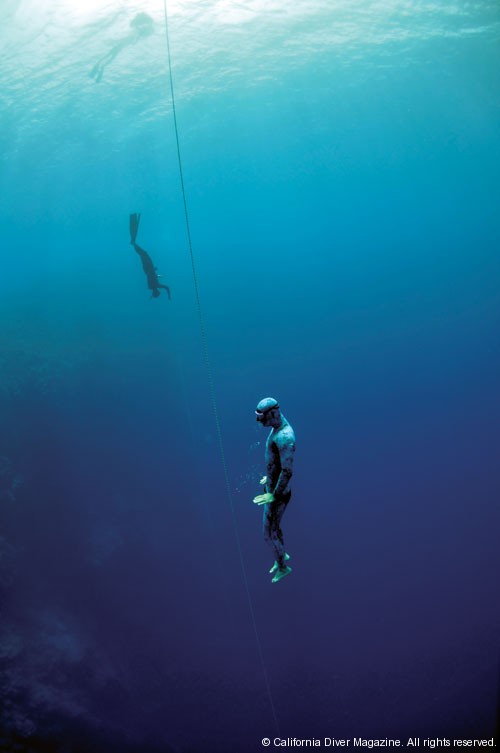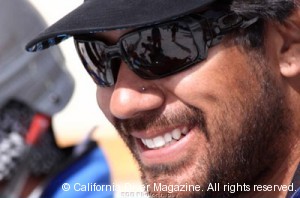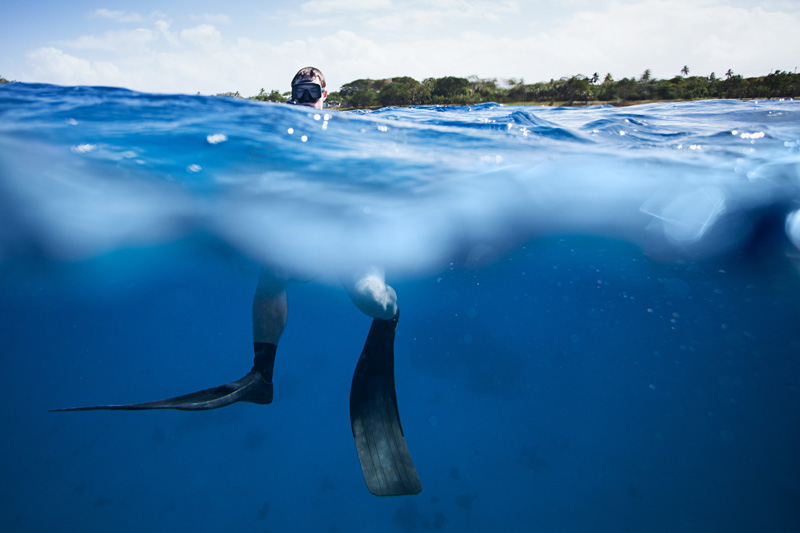Freediving is an inherently dangerous sport. Driving a car is inherently dangerous as well. Adding to this perception, whenever a person in the diving community drowns, the media nearly always emphasizes how hazardous the sport of diving can be, even while the hundreds of injuries and fatalities that occur in traffic accidents daily are rarely mentioned on the evening news.
As professionally trained freedivers, we learn and train to be prepared for blackouts (the loss of consciousness underwater) and sambas (loss of motor control) while diving. Most importantly, we learn to not fear them if we are properly supervised and follow the important rules of freediving safety.
By definition, on every apnea dive we make we are putting our bodies into a hypoxic state, and this hypoxia can have different effects on us. Mild hypoxia is equivalent to the feeling of trying to catch your breath after a light jog, while more severe hypoxia can cause your brain to send random electrical signals through your body, causing what is known as a loss of motor control, or a “samba”. During this loss of motor control, a diver can lose control of his respiratory functions and fine motor skills. A loss of motor control can easily escalate into a full loss of consciousness, also known as a blackout. If you should ever encounter this with your buddy while diving, do everything possible to protect their airway and encourage them to breathe.
 When a blackout occurs, the heart is still pumping blood to the brain, and the majority of the oxygen remaining in your body is still being distributed to the vital organs. A blackout does not mean someone is drowning. If a blackout occurs to someone you’re diving with, be sure to protect the airway, and if conditions permit, remove the mask, blow lightly across their face, tap on the side of their face, and encourage them to breathe. Although these events are scary, several medical studies reveal that these hypoxic events are actually protective mechanisms for your body. With a properly trained buddy who can assist, these events only last a few seconds before the victim returns to full consciousness. If left unassisted, however, these hypoxic events are often fatal.
When a blackout occurs, the heart is still pumping blood to the brain, and the majority of the oxygen remaining in your body is still being distributed to the vital organs. A blackout does not mean someone is drowning. If a blackout occurs to someone you’re diving with, be sure to protect the airway, and if conditions permit, remove the mask, blow lightly across their face, tap on the side of their face, and encourage them to breathe. Although these events are scary, several medical studies reveal that these hypoxic events are actually protective mechanisms for your body. With a properly trained buddy who can assist, these events only last a few seconds before the victim returns to full consciousness. If left unassisted, however, these hypoxic events are often fatal.
The number one rule in freediving safety is to always dive with a buddy. Like many “rules” in diving, this is commonly interpreted to fit the divers’ needs at the time. In the sport of freediving, this is one rule that should never be compromised. Many spearfisherman follow the rule of “same ocean, same day”, and call that a buddy system. However when someone experiences a hypoxic event, they typically don’t make any noise, which makes it especially important to be within an arms-reach of the surfacing diver.
Take into consideration that upon surfacing, a diver must breathe. When a breath is taken, the air must travel into the mouth, down the trachea, into the bronchioles, then into the bronchi, followed by the alveoli, where finally the oxygen is transferred into the blood, where it is then pumped into the heart, and finally sent on its way to the brain – a process that can take up to 30 seconds to complete. It’s therefore important that upon surfacing from a dive, you should watch your buddy for at least 30 seconds.
The next rule is one buddy up, one buddy down. When diving, there should always be someone on the surface waiting for the diver to ensure he/she surfaces safely from their dive, and each diver will alternate as a diver or surface observer. Always be prepared to help your buddy both under water and upon surfacing from the dive.
Often times recreational freedivers will argue that they are not diving very deep – 25 feet or less – and therefore not likely to suffer a shallow water blackout. The truth is that 90% of hypoxic events take place at the surface, once the diver has actually taken his/her first breath, and 9% of hypoxic events happen between 15 feet and the surface, which is referred to as shallow water blackout. It happens most often between these depths because it is where the greatest pressure change in the water column occurs. Therefore, from 15 to the surface is what we refer to as the danger zone. It doesn’t matter if we are diving twenty feet or two hundred feet – this is the most likely place for us to black out underwater.
In an accredited freediving course, such as those offered by Freediving Instructors International, the first thing you will learn about is freediving safety and problem management. It will cover information about what happens in our bodies during a blackout and a samba, how to recognize signs and symptoms of hypoxia, how to help avoid hypoxic events, and how to assist a diver experiencing a samba or blackout. The rescue skills are then practiced in a confined water environment, and later tested in the open water environment.
Remember, freediving can be made into a reasonably safe sport as long as a safety protocol is followed, just like taking a SCUBA certification course makes SCUBA diving much safer. Always dive with a buddy and know your limits, and take a freediving course from a certified professional for years of fun and safe diving.
Go deep – and dive safe!
 Mark Lozano earned his PADI Open Water SCUBA certification at the age of 15. Shortly thereafter he discovered freediving, which quickly became another passion. He trained with world freediving champion Martin Stepanek, the first man to successfully freedive passed 400ft (122m), and founder of Freediving Instructors International. There, Mark earned the designation of an F.I.I. Level 1, 2, and Basic Freediving Safety Instructor. He is the also the US West Coast Representative for F.I.I. and Waterway Company.
Mark Lozano earned his PADI Open Water SCUBA certification at the age of 15. Shortly thereafter he discovered freediving, which quickly became another passion. He trained with world freediving champion Martin Stepanek, the first man to successfully freedive passed 400ft (122m), and founder of Freediving Instructors International. There, Mark earned the designation of an F.I.I. Level 1, 2, and Basic Freediving Safety Instructor. He is the also the US West Coast Representative for F.I.I. and Waterway Company.
All photos and copy copyright by the author and California Diver Magazine and may not be reproduced without express permission.
To contact Mark, email him at Mark@Freedivinginstructors.com

